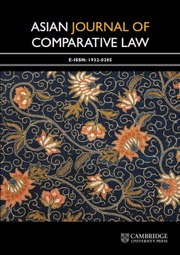Rehan Abeyratne and Ngoc Son Bui's edited collection examines the Unconstitutional Constitutional Amendments (UCA) in two novel ways, first by expanding our theoretical understanding of the UCA to include political discourse, and second, by enlarging its scope to ten Asian jurisdictions including many understudied ones with diverse political systems.Footnote 1 Underpinning the book's focal point on law and politics is the very political nature of constituent power, and how constitutional foundations forming core constitutional values as well as the resulting contestations are necessarily political. In essence, the UCA in practice resides in the intersections of law and politics. Thus, it is this ‘political’ nature of the UCA that this edited book aims to unveil.
The main contribution of the collection is a typology on the law and politics of the UCA in Asia: discursive, denotive, and decisive. The discursive category refers to discussions on the UCA which animate public and scholarly debates involving various actors, but which have not yet formed part of courtroom legal arguments (Japan, China, Vietnam). The denotive category on the other hand, includes courtroom rhetoric on the UCA which have not reached the level of judicial acceptance (Malaysia, Pakistan, Nepal). Finally, the decisive category focuses on the jurisdictions that have invalidated amendments on UCA grounds (Taiwan, Thailand, India, Bangladesh). The typology attempts to capture the mode of engagement of the UCA, even though ‘denotive’ and ‘discursive’ seem to reflect a continuum rather than two distinct categories.Footnote 2 The book's focus on the engagement with UCA in Asia, nevertheless, reveals a broad normative spectrum ranging from consolidating democracy to undermining it.
This book presents both positive and negative constitutional narratives of the UCA, and a central theme recurring in most chapters is how context is key. The constitutional impact of the UCA is largely dependent on contextual factors operating in each jurisdiction, especially in diverse Asia. Sylvia Suteu in her chapter averts the danger of unamendability in fraught political contexts and demonstrates the exclusionary potential of written unamendability or eternity clauses as products of extensive political negotiations.Footnote 3 More importantly, in the typology of judicial nullification methods proposed by Richard Albert (Chapter 12), context becomes crucial especially when judges invalidate amendments based on unwritten core constitutional values that include the rule of law and separation of powers, for violating the basic structure of the constitution.
In such instances, the judiciary, acting as ‘an anti-democratic sword’ overstepping its boundaries (p 232), has often given rise to a tussle between the legislature and the judiciary. This tussle is explicit in India, Taiwan, Nepal, and Thailand. At times, it has modelled judicial behaviour to protect its own turf (Bangladesh, India), and has also led to personalised (Pakistan) and partisan judicial conduct (Nepal). However, in this dialectical relationship between politics and the UCA in Asia where judicial check on political branches is largely a ‘Sisyphean’ task (p 109, eg, Malaysia, Japan), courts have acted as a ‘shield’ (p 232) protecting constitutional foundations (India, Bangladesh, Taiwan), albeit in a more ‘zig-zag’ judicial approach at times (Malaysia). But this can nevertheless be understood as part of the broader scheme of ‘checks and balances’ (p 197) reflecting ‘the people's veto power’ against unconstitutional amendments (p 168). It is this judicial phenomenon that Yaniv Roznai attempts to theorise in his chapter drawing from theorists such as Carl Schmitt and John Hart Ely, offering valuable institutional and cultural explanations including flexible amendment processes and a lack of a political-democratic amendment culture.
Importance of context on constitutional matters, or the UCA in particular,Footnote 4 is not new. Yet, despite the book's focus on political practices of the UCA, this edited collection invites us to consider an emerging and central theoretical problem between courts and the exercise of original constituent power. First, in the form of ‘unconstitutional constitution’ (Vietnam) and the related inquiry, ie, can the judiciary, a constituted authority, invalidate a constitutional provision adopted after an exercise of original constituent power? Second, can the judiciary interfere with the life of a Constituent Assembly that embodies the expression of original constituent power (Nepal)?
These forms of judicial nullification drastically shake the entire edifice of constitutional theory and is subject to severe criticism. But at the core of this criticism lies the assumption that the original constitution is democratic (Thailand). Yet, the reality is far from this as the constitution-making process in Nepal demonstrates (Chapter 7). Theoretically too, it may be untenable to conceptualise Constituent Assemblies as sovereigns with unlimited powers.Footnote 5 While ‘unconstitutional constitution’ on procedural grounds have been identified as a corrective to exclusive expressions of constituent power in constitution-making processes,Footnote 6 can it also involve ‘substantive’ judicial nullification is the next radical frontier of theoretical exploration (p 241).
The rich account of UCA in Asia in this book thus focuses on the politics and the constitutional implications ranging from political discourses on unamendability at one end, to rejecting unamendability, to recognising unamendability based on constitutional foundations, and to the extreme end of locating unamendability in a pre-legal inherent structure of the polity in the form of ‘gyoti’ in Chinese society (Chapter 3). Central to these approaches is the fundamental tension between constituent power and constitutional form in law and politics, and the question of what takes precedenceFootnote 7 – a paradox common to all modern states but coloured in varying shades by their socio-political landscape.
While the book defines ‘politics’ by adopting a more practice-oriented approach (p 7), the narratives, in effect, surface the deeper and ultimate political question: how to find the right form of association, harmoniously combining the people and political authority? Why this edited collection and its diverse constitutional narratives on the UCA is hence thought-provoking, and what it essentially does, is throw light on the question of whether the UCA or the Basic Structure Doctrine is ‘contingent’ on constitutional history; or rather, is it ‘necessary’ (Chapter 13) in the crucial interplay between politics and constitutionalism in any political association of the state.


